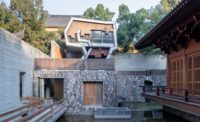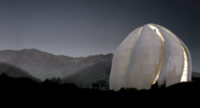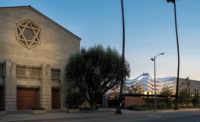The largest synagogue in the world occupies a prominent corner on New York City’s Fifth Avenue across from Central Park. Surprisingly, it has not achieved the acclaim of comparable Manhattan architectural landmarks, such as Grand Central Terminal or Saint Patrick’s Cathedral. Designed by Kohn, Butler, and Stein and completed in 1930, Temple Emanu-El features an imposing limestone facade, marked by a magnificent stained-glass wheel window by Oliver Smith, behind which resides a soaring, 103-foot-high, clear-span basilica, clad in Siena marble and enriched with glass mosaics and gold tiles. The ornamentation is masterful: red, green, and yellow columns with individually distinct capitals support the side galleries; steel trusses with exposed rafters and tie beams spanning the ceiling are covered in plaster and also painted rich reds, blues, greens, and yellows. The room, which seats 2,500, is flanked by the equally stunning Beth-El Chapel. More intimate in scale, it is distinguished by two domes resting on granite columns.
Although the interiors had always been properly maintained, the enormous size of the space and lack of access to many of the areas made cleaning difficult. As a result, 75 years of accumulated city grime, soot, and dust had diminished the original luster of the materials, creating a dingy, oddly monochromatic pallor throughout.
Beyer Blinder Belle Architects & Planners (BBB), the firm responsible for refurbishing Grand Central Terminal in 1998, directed this $30 million restoration and upgrading of the m/e/p systems.
In this case, the solution was not an architectural one in the usual sense. Success depended on meticulous research and planning before any restorative action could be considered. According to project architect Tom Lindberg, AIA, BBB contracted specialists in the industrial roped-access techniques used in rock climbing and caving to survey and document the conditions of inaccessible recesses 100 feet above the floor.
Once that data was collected, the architects began the arduous process of drawing floor plans and elevations and mapping every problem. They were aided by an extensive archive of original material. With the mapping process, BBB located areas of water staining, efflorescence, plaster decay, marble cracks, mosaic-tesserae loss, metal corrosion, and paint failures.
After this phase, the architects began testing multiple treatments for a mind-boggling list of materials, including 20 species of stone––marble, granite, limestone, travertine; ceramic and glass tiles; and marble mosaics––several metals, including ornamental bronze, steel, nickel, and brass; painted and gilded plaster; Guastavino’s sound-absorbing Akoustalith tile; and polychromatic inlaid wood marquetry
PeopleOwner Architect Consulting Restoration Architect: Client Architect: Construction manager Structural Engineer: The Office of James Ruderman LLP 15 West 36th Street New York, NY 10018 212-643-1414
Mechanical/Electrical/Plumbing: Acoustics/Audio System Engineers: Lighting design tained Glass Restoration: Materials conservation Metals conservation Roofing consultant Steeplejack: Decorative Painting & Masonry Cleaning: |
ProductsManufacturers Lighting control system: Electronic Theater Controls, Inc. Bimah chair upholstery fabric: Alexandre Velvet by Old World Weavers Pew upholstery fabric: custom weave by Scalamandre Limestone, granite, travertine cleaner: Enviro Klean 2010 by ProSoCo Akoustilith cleaner: Wishab sponges by Akachemie of Hamburg, Germany |












